What s the Upper Arm Bone Called Again
Basic take many shapes and sizes and are important to add structure to the torso and protection to the vital structures. The basic have a crystalline structure embedded with mineral and alive cells that maintain and repair the skeleton.
Bones take many shapes and sizes and are of import to add construction to the body and protection to the vital structures. The bones take a crystalline construction embedded with mineral and live cells that maintain and repair the skeleton.
Bound to:
- Shoulder Bones
- Arm Bones
- Wrist Bones
- Hand and Finger Bones
- Elbow Bones
Shoulder Basic
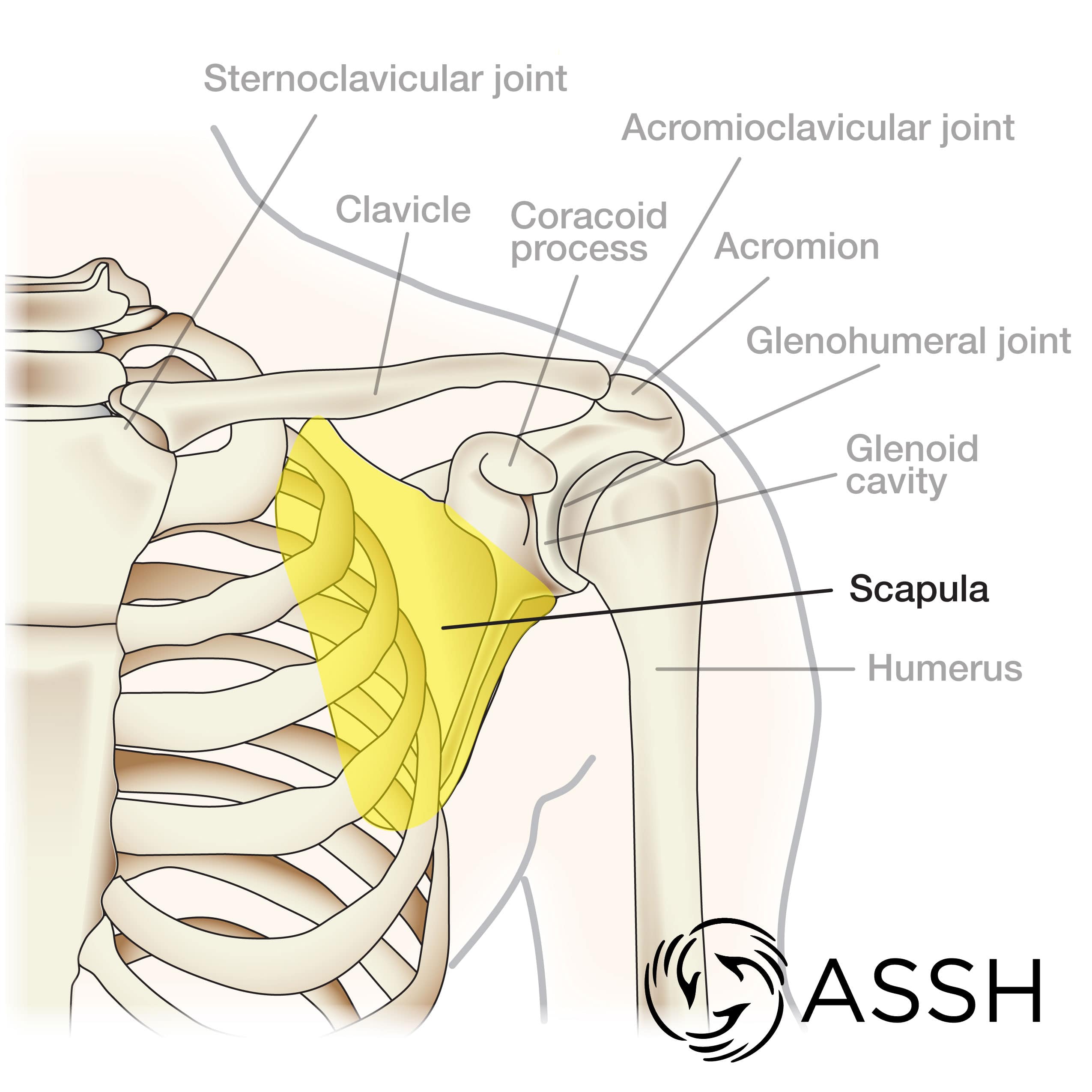 Scapula
Scapula
The scapula, or "shoulder bract," is an approximately triangular shaped bone. It, essentially, floats off of the dorsum of the breast, equally it is connected to the body primarily by musculus. In fact, there are 17 muscles that attach to the scapula. The scapula has a joint that wraps around from the back to the front of the shoulder called the acromion. The acromion is the role of the scapula that attaches to the collar os and is the only true joint attaching the arm to the trunk. Much of the motility of the shoulder is actually motility between the scapula and the chest. Because of this, the principal shoulder articulation (called the glenohumeral joint), the scapula, and the surrounding muscle and ligament are collectively referred to as the shoulder girdle. The shoulder girdle combines to give you shoulder motion. Injuries to the scapula are usually from an awkward fall or car blow.
Clavicle
The clavicle, or "collar os," is a long slightly curved bone that connects the arm to the chest. In most people, the clavicle is like shooting fish in a barrel to feel and even see under the skin. The clavicle attaches to several muscles connecting information technology to the arm, the breast and the neck. There are two ends with joints on the clavicle, and these tin can become arthritic in some people. Clavicle fractures typically happen after a fall or other pregnant trauma.
Acromion
The acromion is a fairly apartment projection of the scapula that curves effectually from the back to the forepart of the shoulder. Much of the potent deltoid muscle effectually the shoulder attaches to the acromion. This bone as well gives the shoulder much of its nigh squared-off shape. In some people there is an extra slice of bone that, during development, did non fuse to the rest of the acromion. This is called an os acromiale. Occasionally the os acromiale can cause discomfort. However, virtually oftentimes information technology does not cause a a trouble. Lying nether the acromion, there is a layer of bursa tissue and some of the rotator cuff. Some people have a curve or hook to the underside of the acromion near the rotator cuff tendons. Surgeons sometimes suggest removal of the curve or hook at the time of surgery.
Coracoid Procedure
The coracoid process is a projection off of the scapula that points directly out to the front of the torso. This piece of the scapula bone is important because information technology has muscles and ligaments attached that help hold the clavicle, the shoulder articulation, and humerus. There are ligaments from the coracoid that help keep the clavicle in place; these tin can be torn in some Air conditioning (acromioclavicular) joint dislocations. Ane of the heads of the biceps attaches to the coracoid. The coracoid usually does not crusade pain or have injuries but tin can occasionally be a crusade for shoulder discomfort.
Glenoid cavity
The glenoid is the socket portion of the ball and socket joint of the shoulder (glenohumeral joint) and is part of the scapula. It is relatively flat which allows the articulation to be the about mobile joint in the body. The glenoid cavity includes the glenoid'due south bone and cartilage surface, and it combines with soft tissues like the glenoid labrum, multiple shoulder ligaments and the joint sheathing (the lining of the joint) to make the joint stable. While the joint is usually stable, lots of motion, injury or aberration in any of the structures of the glenoid cavity can lead to joint instability. Occasionally, the shoulder can lose move from weather such equally arthritis or adhesive capsulitis (frozen shoulder).
Arm Bones
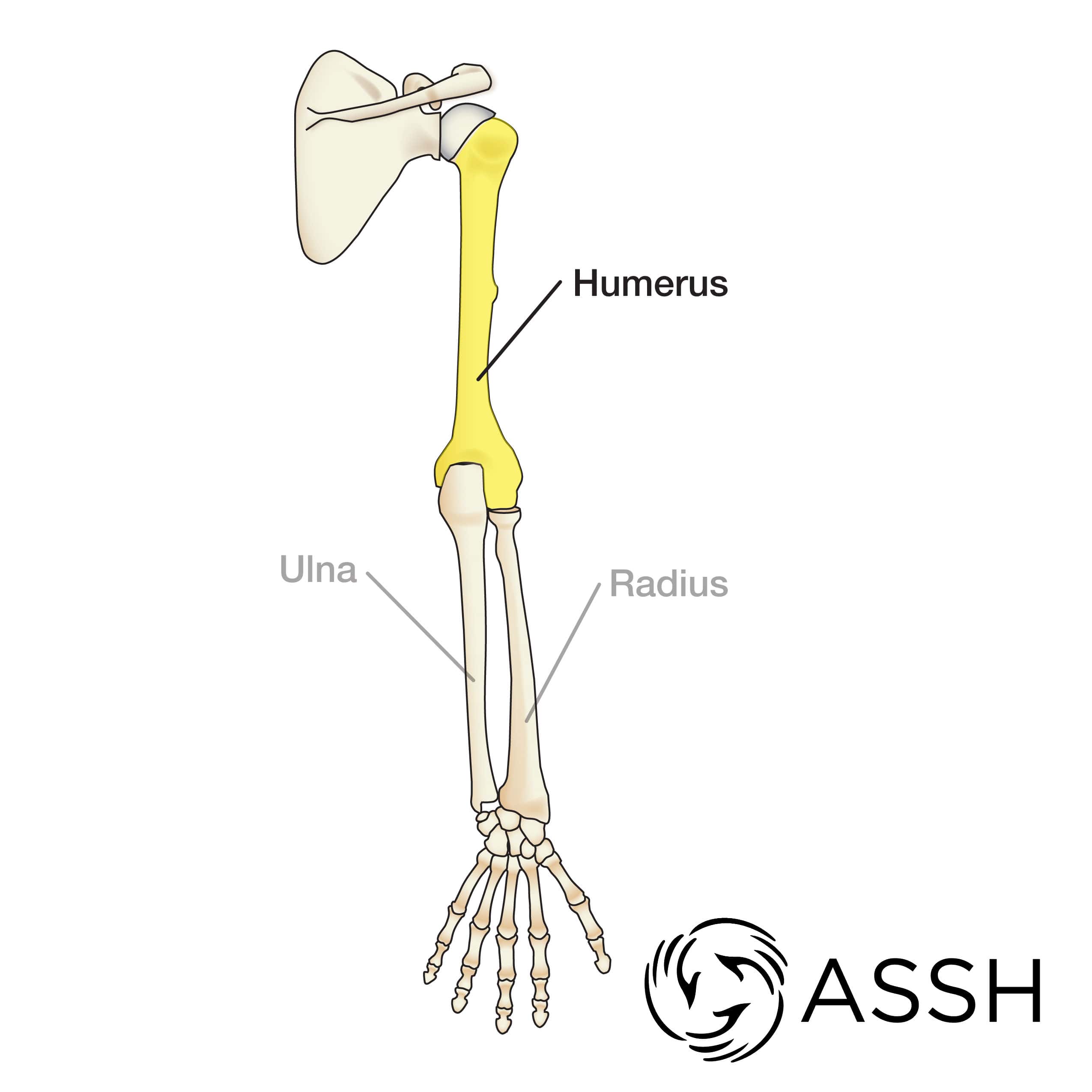 Humerus
Humerus
The humerus is the long bone between the shoulder and the elbow. It has the ball of the ball and socket of the shoulder (glenohumeral) articulation. At the other end, it has its portion of the elbow articulation. The humerus serves every bit an attachment of many muscles and ligaments in the arm. Some of the fastened muscles run all the mode into the manus. The humerus typically becomes a trouble simply when information technology breaks (fractures). There are many types of humerus fractures and as a result, the treatments for these fractures are quite variable.
Radius
The radius is one of the 2 forearm bones and is on the thumb side of the forearm near the hand, but is always on the outside of the elbow. The position of the radius changes depending on how the mitt is turned because the radius twists around the other forearm bone, the ulna. At the elbow, the radius is part of the odd shaped joint between the humerus and the two forearm bones. The articulation between the radius and humerus by itself is like a brawl and socket articulation, with the radius forming the socket. The radius has many muscular attachments to move the elbow, forearm, wrist and fingers. The finish of the radius leads to the wrist joint. The radius and ulna are joined by cartilage joints at the elbow and at the wrist. They are also joined past multiple ligaments. In that location are many ways that people injure the radius and the forearm. Breaking this os is common considering when we fall, the hands and arms are typically used to break the fall.
Ulna
The ulna is one of the two forearm bones and is on the small finger side of the forearm. Different the radius, this bone does not twist, then when the hand changes position, the ulna is always in the same position on the inside role of the forearm. Similar the radius, the ulna has joints at the elbow and wrist. The joint betwixt the ulna and humerus is a hinge type of joint. At the wrist, the ulna has a smaller surface in contact with the wrist bones and typically bears less of the force from the manus and wrist. The ulna is joined to the radius throughout the forearm with cartilage joints at the elbow and wrist and multiple ligaments connecting to the radius through the whole length of the forearm. Like the radius, breaking the ulna bone is a common reason for issues with the ulna.
Wrist Bones
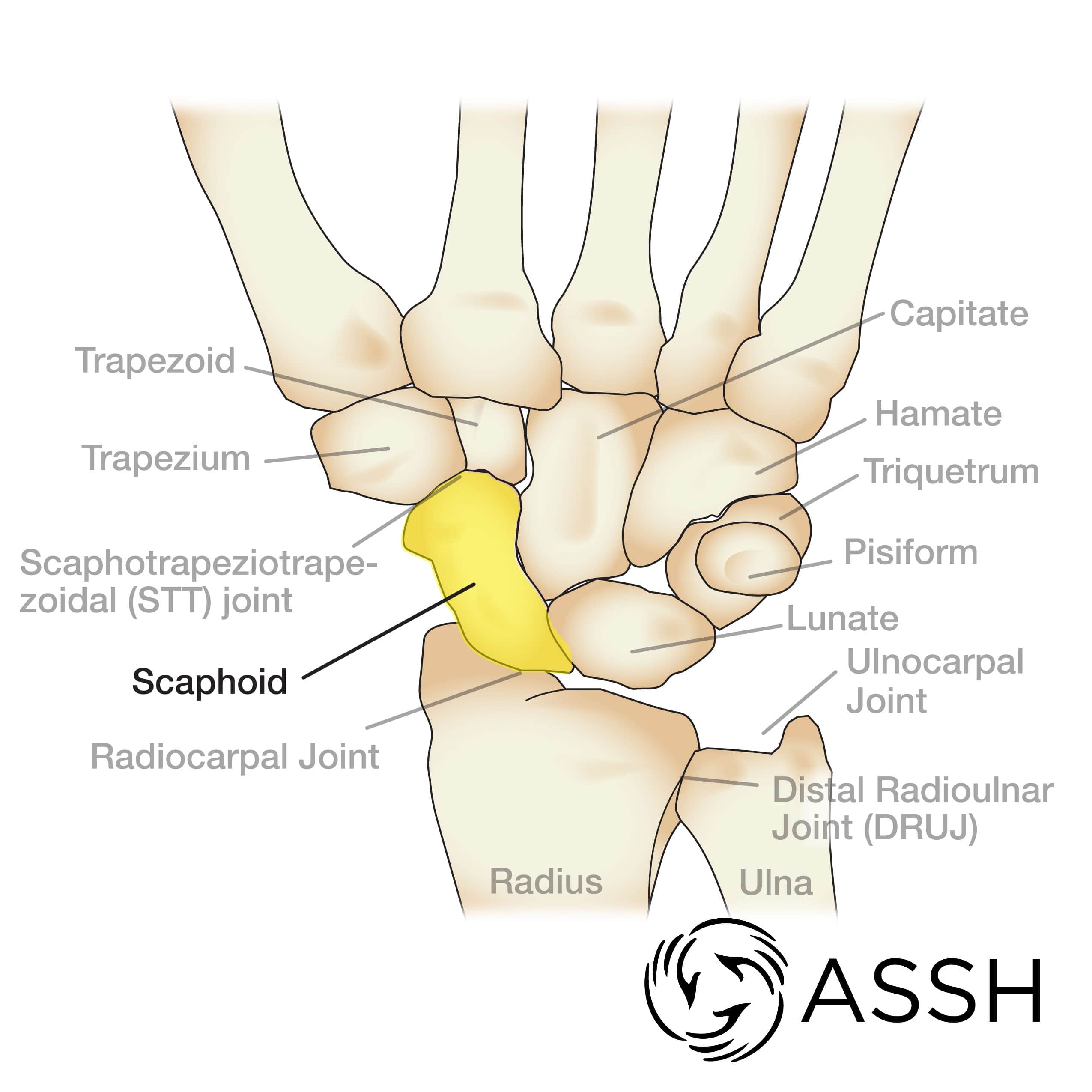 Scaphoid
Scaphoid
The scaphoid is a bone in the wrist. Information technology is office of the first row of wrist bones, simply information technology helps to link the two rows of wrist basic together. Its name derives from the Greek word for gunkhole because it's thought that the scaphoid resembles a boat. Most of the scaphoid is covered with cartilage which contacts 5 other bones in the wrist and forearm. The office of the scaphoid without cartilage is fastened to ligaments and has blood vessels that come up from the radial artery. Bones need claret flow to heal. A broken or fractured scaphoid can accept difficulty healing, or may never heal, because of a disruption of blood flow through the scaphoid. An intact scaphoid is important and necessary for proper wrist role considering of how it interacts with the other wrist bones.
Lunate
The lunate is a bone in the heart of the wrist in the first row of wrist bones. Like most of the wrist bones, it is almost entirely covered in cartilage. This bone has a crescent shape when seen from the side and its big cartilage surface allows for significant wrist motion. It is uncommon to interruption the lunate, only the lunate tin be involved with dislocations of the wrist and tin rub against the ulna if the ulna is besides long compared to the radius bone.
Triquetrum
The triquetrum is a bone on the minor finger side of the wrist in the first row of wrist bones. This bone adds stability to the wrist, gives the wrist a larger surface to conduct weight transmitted from the hand, and makes a joint with other carpal bones including the pisiform.
Trapezoid
This is a roughly trapezoidal-shaped bone in the second row of wrist basic and primarily holds the index finger metacarpal os in place. This bone is uncommonly injured.
Trapezium
The trapezium is a saddle-shaped bone in the 2d row of wrist basic, and it is the principal place where the thumb metacarpal connects to the wrist. This bone has an odd shape that allows the pollex to movement in multiple directions, yet information technology stabilizes pollex as well. In that location are two principal bug seen with this wrist bone. Breaking (fracturing) the bone is common, but the most common problem is arthritis between the trapezium and the bones it sits next to in the wrist and thumb.
Capitate
The capitate is a big bone in the center of the 2d row of wrist basic. Information technology forms joints with multiple bones in the wrist and hand. It sits primarily under the middle finger metacarpal bone. This bone makes an important contribution to wrist motility.
Hamate
The hamate is a large, unusually shaped, bone that has an almost triangular shape when seen from the top and is located in the second row of wrist basic. Equally with the other wrist basic. it serves every bit attachment points for multiple ligaments and works with multiple other bones. Information technology is i of the zipper points for the ligament involved in carpal tunnel syndrome. It holds upwards the ring and niggling finger metacarpal bones. The hamate can be injured in more than than one way. Oft, the hamate can intermission when people use the paw for punching. Also, the claw of the hamate can fracture during a autumn or if struck directly, such as when a baseball role player swings a bat or golfer swings a golf game guild.
Pisiform
The pisiform is a small sesamoid bone (a bone within a tendon) that sits in the wrist and is in the flexor carpi ulnaris tendon. Like other sesamoid bones, information technology changes the management of pull of the tendon to which it is attached. Occasionally, the pisiform can break or can take arthritis in the articulation it makes with the triquetrum.
Hand and Finger Bones
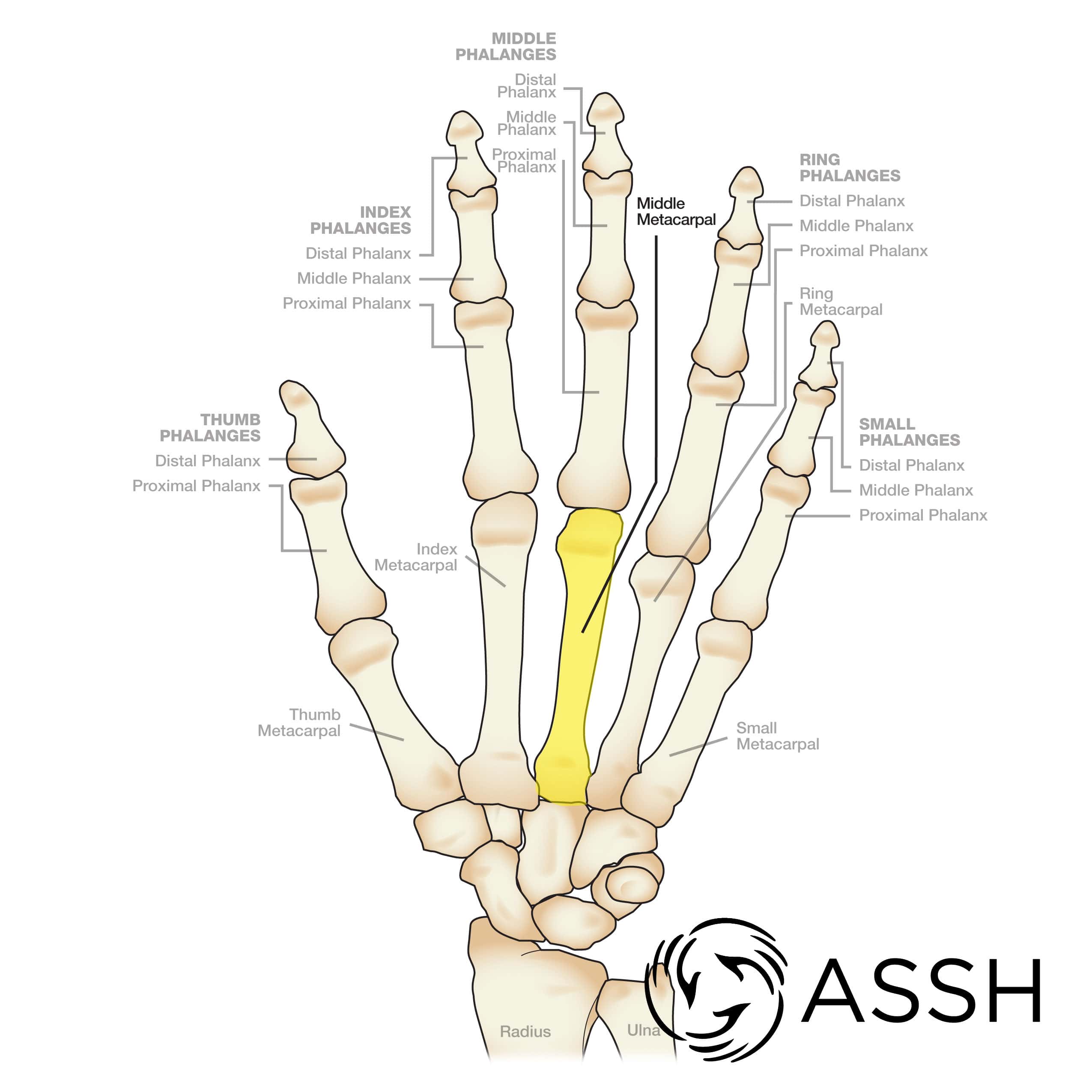 Finger Metacarpals
Finger Metacarpals
The metacarpals of the fingers brand up the bone structure of virtually of the hand. They are all like in shape and have joints in the wrist on ane end, and the finger at the other cease. The alphabetize and heart finger metacarpals take very little movement, while the metacarpals of the ring and little finger movement much more than.
Proximal phalanges
The proximal phalanx of the fingers is the proximal, or commencement bone, in the fingers when counting from the hand to the tip of the finger. There are three phalanges in each finger. The proximal phalanx is the largest of the iii bones in each finger. The proximal phalanx has joints with the metacarpal and with the middle phalanx.
Centre phalanges
The middle phalanx of the finger is the middle or second of the three bones in each finger when counting from the hand to the tip of the finger. The eye phalanx has joints with the proximal phalanx and with the distal phalanx of the finger.
Distal phalanges
The distal phalanx of the finger is the distal or third of the three bones in each finger when counting from the mitt to the tip of the finger. The distal phalanx has a joint just with the heart phalanx. On the tip of the phalanx is a bulbous tuft of bone that helps give the finger its rounded appearance. The distal phalanx is too important for supporting the fingernail.
Thumb metacarpal
The thumb metacarpal is similar in shape to the metacarpals of the fingers, simply it is thicker. The thumb metacarpal has significantly more motion than the other metacarpals. Information technology makes a joint with the trapezium that allows much of the thumb movement. This articulation allows the thumb to motion in a manner that allows pinching. This is largely due to the unusual shape of the base of the metacarpal and the trapezium. The head of the metacarpal has a large joint surface next to the thumb proximal phalanx.
Thumb sesamoids
The thumb sesamoids are two minor round bones at about the level of the pollex metacarpophalangeal joint These bones, every bit with all sesamoid bones, prevarication within tendons. The flexor pollicis brevis tendon and the adductor pollicis adhere to the pollex sesamoids. Sesamoid bones help alter the line of pull for their tendons which can help increase the strength of tendon pull across the joint.
Thumb proximal phalanx
The thumb proximal phalanx is a short and stout os between the metacarpal and distal phalanx. There is no eye phalanx in the pollex.
Thumb distal phalanx
The pollex distal phalanx is a brusque bone with a rounded tuft at the end that makes a articulation with the proximal phalanx. The bulbous tuft at the end of the bone gives the thumb its rounded end. This bone supports the thumb boom.
Elbow Bones
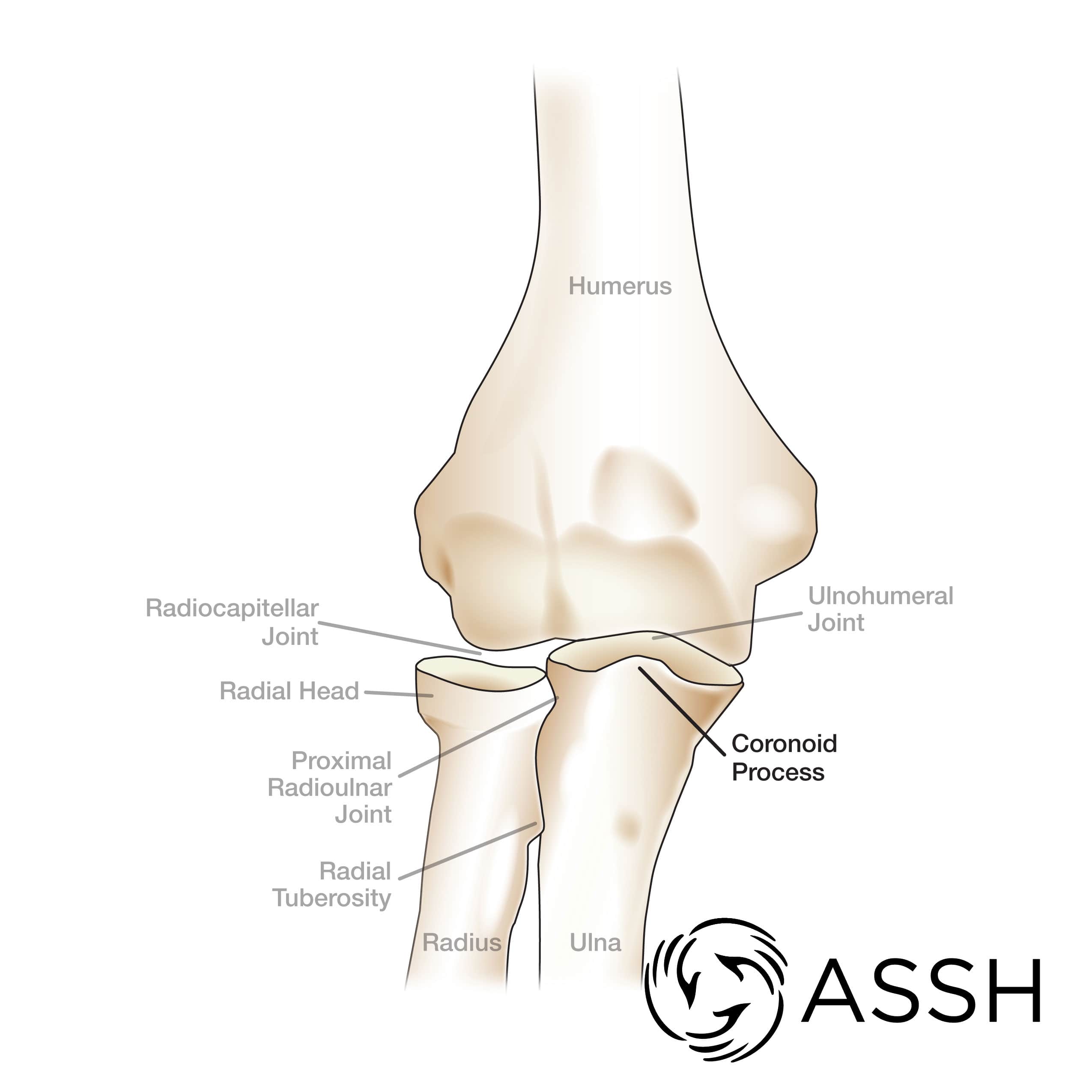 Coronoid process
Coronoid process
The coronoid procedure is a small project of bone off of the ulna bone that sits in the front of the elbow and on the inside of the elbow On and very most the coronoid process are attachment sites for muscles and ligaments of the elbow joint. The coronoid process is of import for calculation stability to the elbow.
Radial head
The radial caput is a somewhat rounded loving cup that joins with the humerus and ulna to make up a portion of the elbow joint. The radial head has cartilage surfaces for both the humerus and the ulna to allow bending and extending of the elbow and twisting of the forearm. It also can add together a significant corporeality of stability to the elbow articulation.
Radial tuberosity
The radial tuberosity is a small, polish projection on the surface of the radius bone almost the elbow. It is the zipper site for the biceps tendon in the forearm. Because of the position of the tuberosity on the radius, the biceps tendon twists the hand palm up the forearm.
Lateral epicondyle
The lateral epicondyle is a os projection off of the outside of the humerus os. It is of import primarily because of its soft tissue attachments to ligament and tendon.
Medial epicondyle
The medial epicondyle is a bone projection of the within of the humerus bone. It is important primarily because of its soft tissue attachments to ligament and tendon. The ulnar collateral ligament and the common flexor tendon adhere here. The ulnar nerve runs immediately behind the medial epicondyle.
Olecranon
The olecranon is a big projection of os on the back of the elbow. It is a part of the ulna bone and makes the point of the elbow.
Source: https://www.assh.org/handcare/safety/bones
0 Response to "What s the Upper Arm Bone Called Again"
Post a Comment